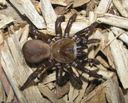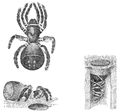Cork-lid trapdoor spiders
Halonoproctidae
Classification
- Phylum: Arthropoda
- Subphylum: Chelicerata
- Class: Arachnida
- Order: Araneae
- Infraorder: Mygalomorphae
- Family: Halonoproctidae
Pronunciation
How to pronounce Halonoproctidae: /həˌloʊnəˈprɒktɪdiː/
These audio files are automatically generated. While they are not always 100% accurate, they are a good starting point.
Images






Summary
Halonoproctidae, or cork-lid trapdoor spiders, are a family of mygalomorph spiders characterized by their burrow construction with trapdoors. They are predominantly insectivorous and are notable for their unique physical adaptations, including specialized spines and spinnerets.
Physical Characteristics
Medium to large spiders (10 - 30 mm) with a color range from light brown to black, typically without distinctive markings. The carapace is hairless with few spines, and the sternum is longer than wide. Females lack scopulae but have curved spines on legs I and II, while males possess scopulae and prominent spines on their anterior legs. Two pairs of spinnerets are present: short unsegmented posterior median and longer segmented posterior lateral spinnerets.
Identification Tips
Look for the silk-lined burrows with a hinged trapdoor that is camouflaged with debris. Males may wander in search of prey, while females rarely leave their burrows.
Habitat
Burrows with trapdoors in various environments across their distribution range.
Distribution
Widely distributed in North and Central America, Australasia, Asia, southern Europe, and North Africa. One species recorded from Venezuela in South America.
Diet
Predominantly insectivorous, they rush out to capture prey upon sensing vibrations.
Reproduction
Females rarely leave burrows, and specific details on reproductive habits are not provided.
Ecosystem Role
As predators, they help maintain the insect population in their ecosystems by capturing various insects.
Evolution
Originally described as the subfamily Halonoproctinae of Ctenizidae by R. I. Pocock in 1901. Elevated to family status in 2018 after molecular studies revealed monophyly.
Similar Taxa
- Ctenizidae
Tags
- spiders
- trapdoor spiders
- Halonoproctidae
- taxonomy
- arachnology